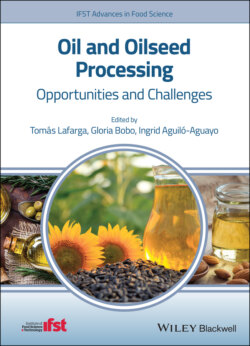Читать книгу Oil and Oilseed Processing - Ingrid Aguilo-Aguayo - Страница 34
2.2.3 Nutritional Properties
ОглавлениеOilseeds are a source of fiber and minerals such as phosphorus, iron, and magnesium. Generally, they are a source of vitamin E (an antioxidant), folate, and niacin. Also contain phytoestrogens, which is a group of substances including isoflavones (McKevith 2005). Soybean and sunflower seeds are a rich source of lipids with triacylglycerols as the main constituents. Proteins and phospolipds and bioactive compounds such as vitamin E are also present (White et al. 2006). This is of particular importance in the field of pharmacology, food, and personal care (Sukhotu et al. 2016). Table 2.2 shows the main composition table of the main oilseed oils (USDA 2020). As observed, sunflower oil is a potential source of vitamin E and soybean oil of vitamin K. Regarding the PUFA content, sunflower, soybean, flaxseed, and poppy seed oil present the highest values, whereas coconut has a considerably high saturated fatty acid content (Table 2.2).
Table 2.1 Some physical characteristics of conventional oilseed oils.
| Parameters | Palm kernel oil | Palm oil | Soybean oil | Rapeseed oil | Sunflower oil | Groundnut oil | Olive oil | Coconut oil |
|---|---|---|---|---|---|---|---|---|
| Specific gravity value (relative to pure water) | 0.904 | 0.9020 | 0.9150–0.9280 | 0.9123 | 1.521517 | 0.9155 | 0.910–0.915 | 0.91 |
| Refractive index (t = 40 °C) | 14 490 – 14 520 | 14 530 – 14 560 | 14 660 – 14 700 | 1465–1.469 | 14 610 – 14 680 | 1.47 | 14 670 – 14 710 (at 20 °C) | 14 480 – 14 500 |
| Saponification value (mg KOH/g) | 280.5 | 200.05 | 188–195 | 172.29 | 177.06 | 191.5 | 189.30 | 257.5 |
| Acid value (mg KOH/g) | 2.7 | 0.84 | ≤0.5 | 1.78 | 0.22 | 9.0 | 0.84 | 5.5 |
| Peroxide value (mEq/kg) | 14.3 | 7.98 | ≤10 | 0.63 | 9.99 | 9.99 | 7.98 | – |
| Iodine value (mg KOH/g) | 15.86 | 602.7 | 75–94 | 1198.9 | 94.35 | 9.4 | 831 | 8.5 |
| Viscosity, mPA s (30 °C) | 43 | 45 (at 45 °C) | 45 | 72–82 (at 20 °C) | 47 | 45 | 55 | 39 |
| Flash point, °C | 267 | 314 | 317–324 | 317 | 316 | 315 | 300–330 | 300/288 /270 |
Source: Chadwick 1988; Bailey and Shahidi 2005; Firestone 2006; Tan et al. 2009; Azlan et al. 2010; Neagu et al. 2013; Amira et al. 2014; Roiaini et al. 2015; Alajtal et al. 2018; Godswill et al. 2018; Xu et al. 2018; Beszterda and Nogala‐Kałucka 2019.
Table 2.3 presents the main fatty acids in oilseed oils. Linoleic acid, oleic, and α‐linolenic acids are the primarily unsaturated fatty acids accounting for 88.83% of total lipids. Palmatic acid is the major saturated fatty acid (10.42%). As reported in Ramos et al. (2009), linoleic acid (54.0%), oleic (23.9%), palmitic acid (11.3%), and α‐linolenic acids (6.1%) are the major fatty acids present in soybean oil. Canola oil, also known in Europe as rapeseed oil, has low concentrations of saturated lipids and, in line with soybean, the protein content is high. In particular, percentages of 23 and 40% have been reported in rapeseed and soybean respectively (Bauer and Kostik 2014).
